ECO 4012: UK Macroeconomic Policies, Successes & Challenges
VerifiedAdded on 2023/06/12
|14
|3735
|439
Essay
AI Summary
This essay provides a comprehensive analysis of macroeconomic policies and their application in the UK, focusing on the goal of improving economic welfare. It begins by defining macroeconomics and its objectives, including managing inflation, improving living standards, and achieving sustainable economic growth. The essay discusses the UK's mixed economic system, which combines elements of socialism and capitalism, and examines various macroeconomic policies, such as monetary and fiscal policies, used by the government. It highlights the challenges faced by the UK in recent years, including the impact of Brexit and the Covid-19 pandemic, which have led to economic instability and inflation. The essay also touches upon obstacles in achieving macroeconomic goals, such as wage differentials, gender disparities, and labor market issues, and suggests potential solutions for these problems. This resource is available on Desklib, a platform offering a wealth of study tools and solved assignments for students.
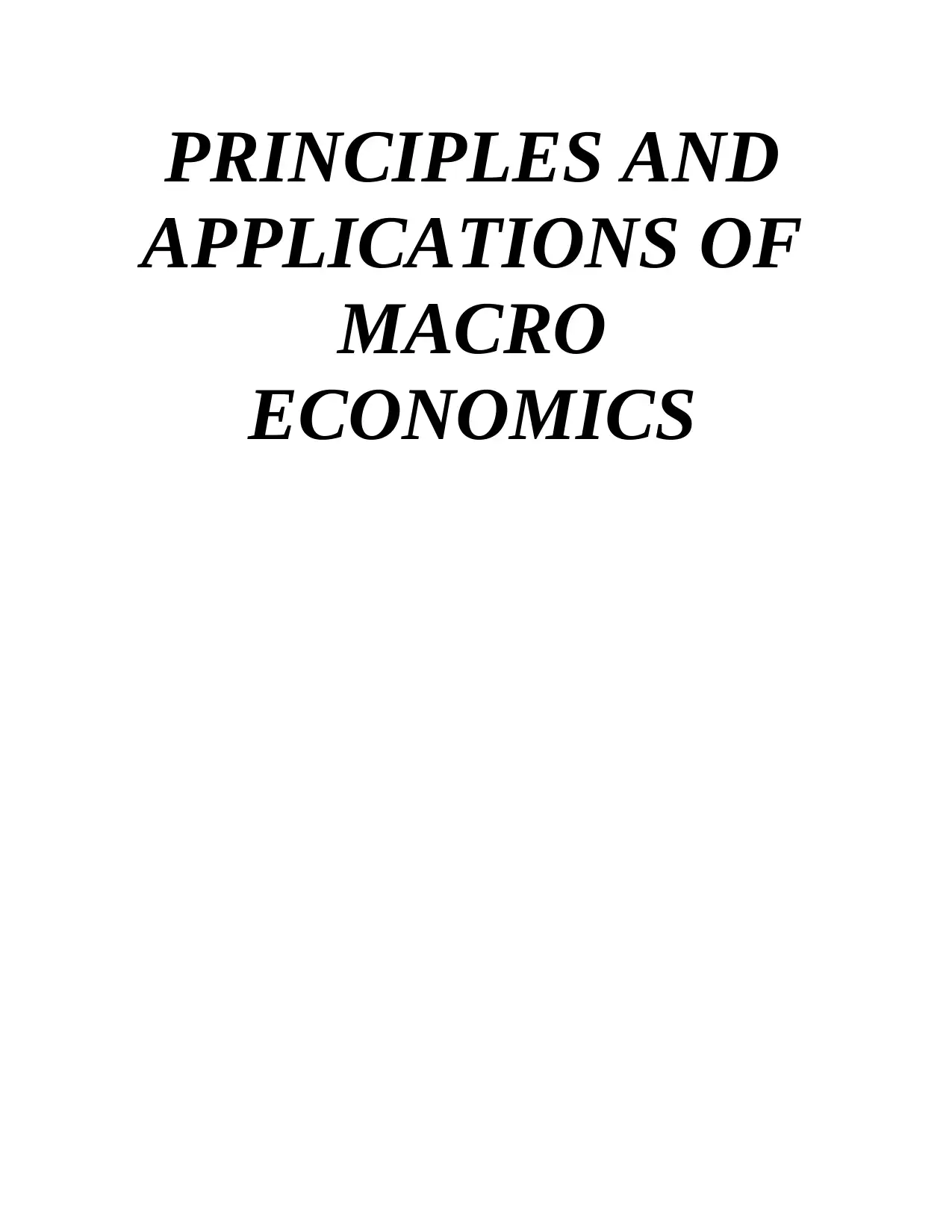
PRINCIPLES AND
APPLICATIONS OF
MACRO
ECONOMICS
APPLICATIONS OF
MACRO
ECONOMICS
Paraphrase This Document
Need a fresh take? Get an instant paraphrase of this document with our AI Paraphraser
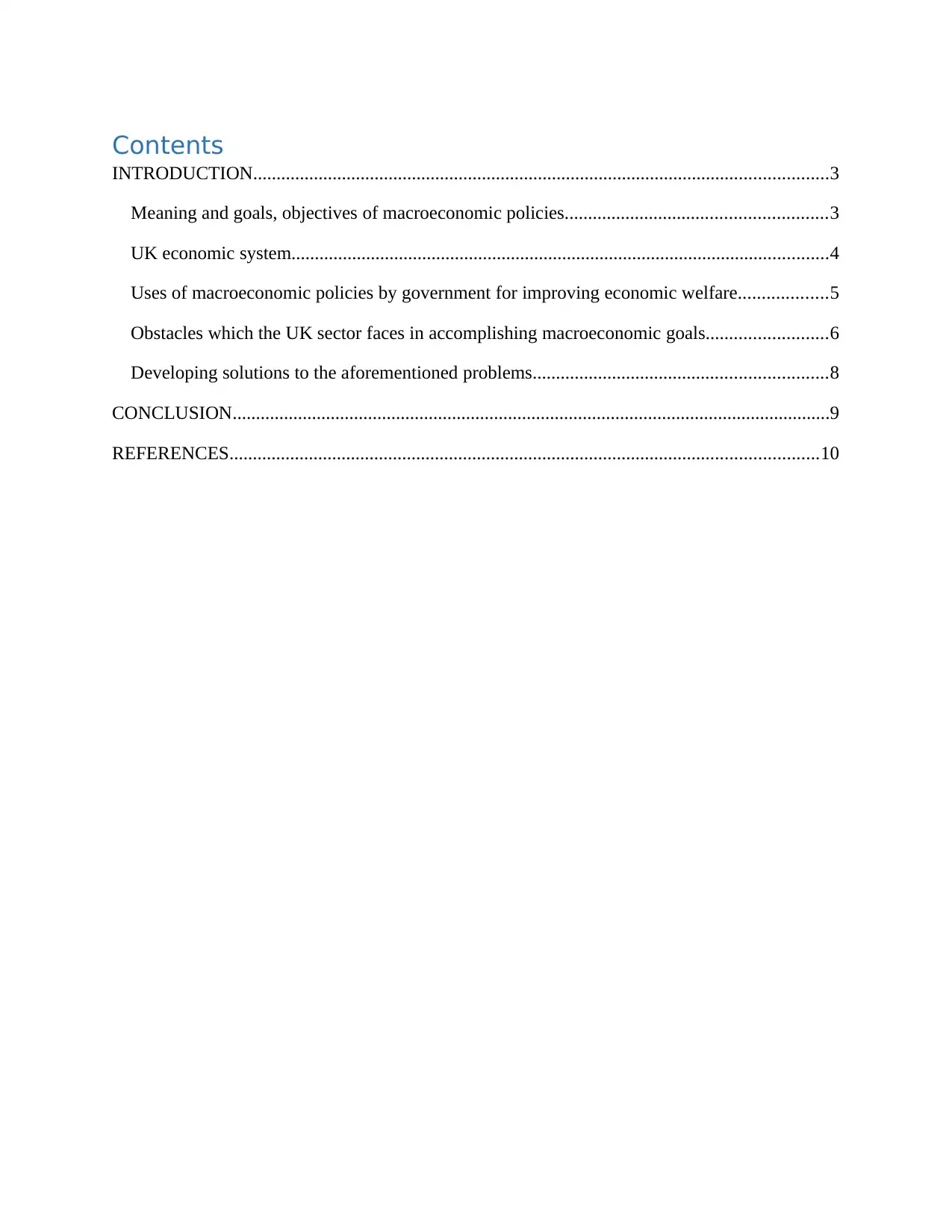
Contents
INTRODUCTION...........................................................................................................................3
Meaning and goals, objectives of macroeconomic policies........................................................3
UK economic system...................................................................................................................4
Uses of macroeconomic policies by government for improving economic welfare...................5
Obstacles which the UK sector faces in accomplishing macroeconomic goals..........................6
Developing solutions to the aforementioned problems...............................................................8
CONCLUSION................................................................................................................................9
REFERENCES..............................................................................................................................10
INTRODUCTION...........................................................................................................................3
Meaning and goals, objectives of macroeconomic policies........................................................3
UK economic system...................................................................................................................4
Uses of macroeconomic policies by government for improving economic welfare...................5
Obstacles which the UK sector faces in accomplishing macroeconomic goals..........................6
Developing solutions to the aforementioned problems...............................................................8
CONCLUSION................................................................................................................................9
REFERENCES..............................................................................................................................10
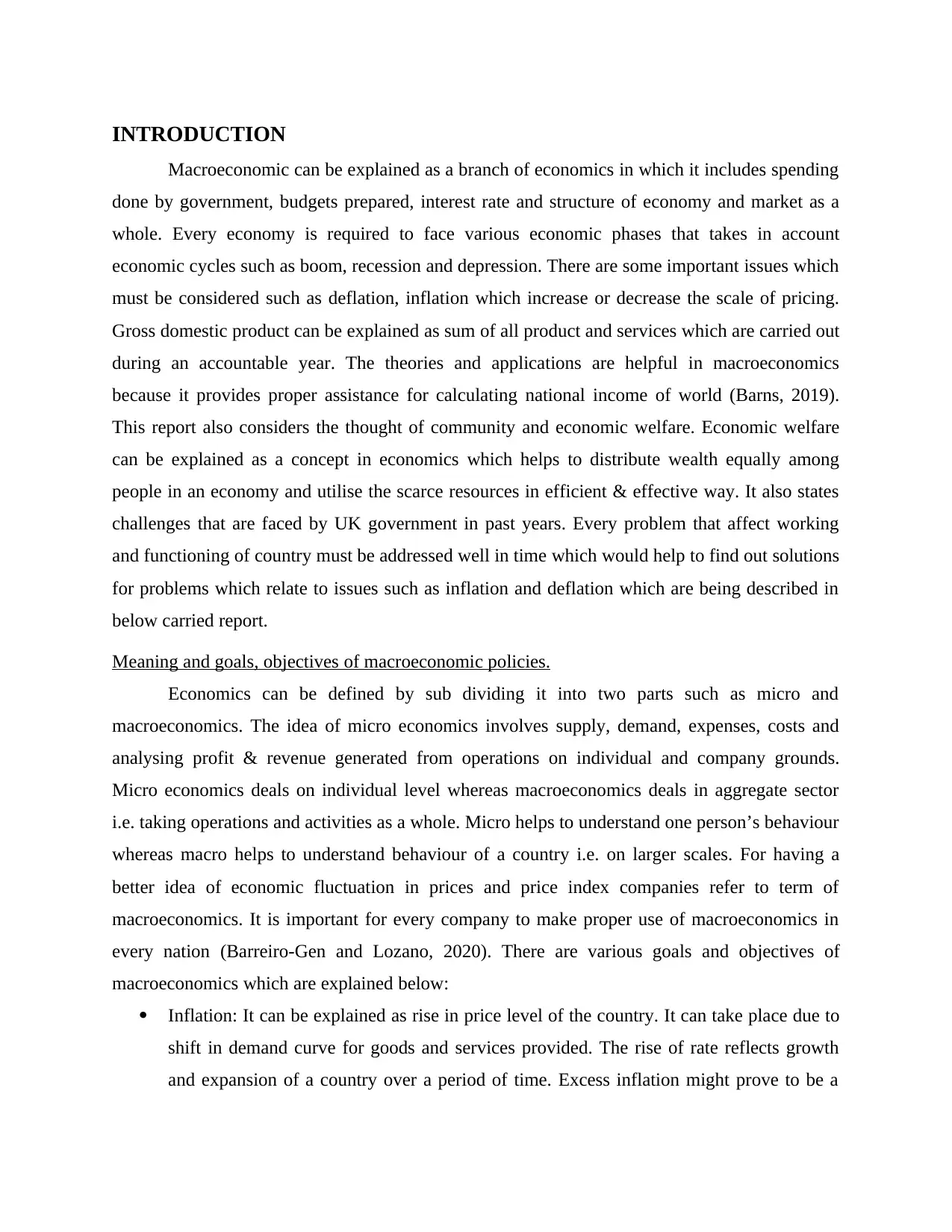
INTRODUCTION
Macroeconomic can be explained as a branch of economics in which it includes spending
done by government, budgets prepared, interest rate and structure of economy and market as a
whole. Every economy is required to face various economic phases that takes in account
economic cycles such as boom, recession and depression. There are some important issues which
must be considered such as deflation, inflation which increase or decrease the scale of pricing.
Gross domestic product can be explained as sum of all product and services which are carried out
during an accountable year. The theories and applications are helpful in macroeconomics
because it provides proper assistance for calculating national income of world (Barns, 2019).
This report also considers the thought of community and economic welfare. Economic welfare
can be explained as a concept in economics which helps to distribute wealth equally among
people in an economy and utilise the scarce resources in efficient & effective way. It also states
challenges that are faced by UK government in past years. Every problem that affect working
and functioning of country must be addressed well in time which would help to find out solutions
for problems which relate to issues such as inflation and deflation which are being described in
below carried report.
Meaning and goals, objectives of macroeconomic policies.
Economics can be defined by sub dividing it into two parts such as micro and
macroeconomics. The idea of micro economics involves supply, demand, expenses, costs and
analysing profit & revenue generated from operations on individual and company grounds.
Micro economics deals on individual level whereas macroeconomics deals in aggregate sector
i.e. taking operations and activities as a whole. Micro helps to understand one person’s behaviour
whereas macro helps to understand behaviour of a country i.e. on larger scales. For having a
better idea of economic fluctuation in prices and price index companies refer to term of
macroeconomics. It is important for every company to make proper use of macroeconomics in
every nation (Barreiro‐Gen and Lozano, 2020). There are various goals and objectives of
macroeconomics which are explained below:
Inflation: It can be explained as rise in price level of the country. It can take place due to
shift in demand curve for goods and services provided. The rise of rate reflects growth
and expansion of a country over a period of time. Excess inflation might prove to be a
Macroeconomic can be explained as a branch of economics in which it includes spending
done by government, budgets prepared, interest rate and structure of economy and market as a
whole. Every economy is required to face various economic phases that takes in account
economic cycles such as boom, recession and depression. There are some important issues which
must be considered such as deflation, inflation which increase or decrease the scale of pricing.
Gross domestic product can be explained as sum of all product and services which are carried out
during an accountable year. The theories and applications are helpful in macroeconomics
because it provides proper assistance for calculating national income of world (Barns, 2019).
This report also considers the thought of community and economic welfare. Economic welfare
can be explained as a concept in economics which helps to distribute wealth equally among
people in an economy and utilise the scarce resources in efficient & effective way. It also states
challenges that are faced by UK government in past years. Every problem that affect working
and functioning of country must be addressed well in time which would help to find out solutions
for problems which relate to issues such as inflation and deflation which are being described in
below carried report.
Meaning and goals, objectives of macroeconomic policies.
Economics can be defined by sub dividing it into two parts such as micro and
macroeconomics. The idea of micro economics involves supply, demand, expenses, costs and
analysing profit & revenue generated from operations on individual and company grounds.
Micro economics deals on individual level whereas macroeconomics deals in aggregate sector
i.e. taking operations and activities as a whole. Micro helps to understand one person’s behaviour
whereas macro helps to understand behaviour of a country i.e. on larger scales. For having a
better idea of economic fluctuation in prices and price index companies refer to term of
macroeconomics. It is important for every company to make proper use of macroeconomics in
every nation (Barreiro‐Gen and Lozano, 2020). There are various goals and objectives of
macroeconomics which are explained below:
Inflation: It can be explained as rise in price level of the country. It can take place due to
shift in demand curve for goods and services provided. The rise of rate reflects growth
and expansion of a country over a period of time. Excess inflation might prove to be a
⊘ This is a preview!⊘
Do you want full access?
Subscribe today to unlock all pages.

Trusted by 1+ million students worldwide
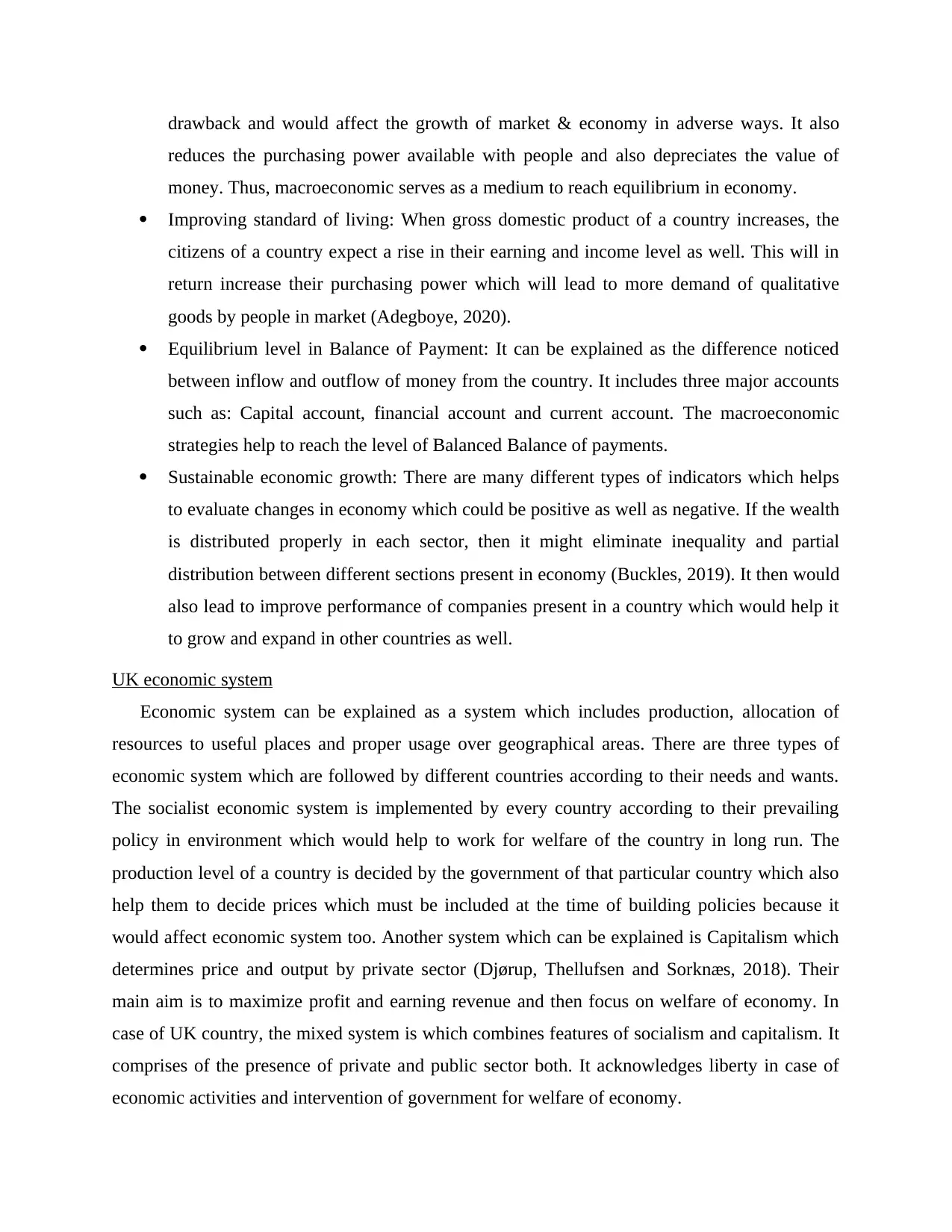
drawback and would affect the growth of market & economy in adverse ways. It also
reduces the purchasing power available with people and also depreciates the value of
money. Thus, macroeconomic serves as a medium to reach equilibrium in economy.
Improving standard of living: When gross domestic product of a country increases, the
citizens of a country expect a rise in their earning and income level as well. This will in
return increase their purchasing power which will lead to more demand of qualitative
goods by people in market (Adegboye, 2020).
Equilibrium level in Balance of Payment: It can be explained as the difference noticed
between inflow and outflow of money from the country. It includes three major accounts
such as: Capital account, financial account and current account. The macroeconomic
strategies help to reach the level of Balanced Balance of payments.
Sustainable economic growth: There are many different types of indicators which helps
to evaluate changes in economy which could be positive as well as negative. If the wealth
is distributed properly in each sector, then it might eliminate inequality and partial
distribution between different sections present in economy (Buckles, 2019). It then would
also lead to improve performance of companies present in a country which would help it
to grow and expand in other countries as well.
UK economic system
Economic system can be explained as a system which includes production, allocation of
resources to useful places and proper usage over geographical areas. There are three types of
economic system which are followed by different countries according to their needs and wants.
The socialist economic system is implemented by every country according to their prevailing
policy in environment which would help to work for welfare of the country in long run. The
production level of a country is decided by the government of that particular country which also
help them to decide prices which must be included at the time of building policies because it
would affect economic system too. Another system which can be explained is Capitalism which
determines price and output by private sector (Djørup, Thellufsen and Sorknæs, 2018). Their
main aim is to maximize profit and earning revenue and then focus on welfare of economy. In
case of UK country, the mixed system is which combines features of socialism and capitalism. It
comprises of the presence of private and public sector both. It acknowledges liberty in case of
economic activities and intervention of government for welfare of economy.
reduces the purchasing power available with people and also depreciates the value of
money. Thus, macroeconomic serves as a medium to reach equilibrium in economy.
Improving standard of living: When gross domestic product of a country increases, the
citizens of a country expect a rise in their earning and income level as well. This will in
return increase their purchasing power which will lead to more demand of qualitative
goods by people in market (Adegboye, 2020).
Equilibrium level in Balance of Payment: It can be explained as the difference noticed
between inflow and outflow of money from the country. It includes three major accounts
such as: Capital account, financial account and current account. The macroeconomic
strategies help to reach the level of Balanced Balance of payments.
Sustainable economic growth: There are many different types of indicators which helps
to evaluate changes in economy which could be positive as well as negative. If the wealth
is distributed properly in each sector, then it might eliminate inequality and partial
distribution between different sections present in economy (Buckles, 2019). It then would
also lead to improve performance of companies present in a country which would help it
to grow and expand in other countries as well.
UK economic system
Economic system can be explained as a system which includes production, allocation of
resources to useful places and proper usage over geographical areas. There are three types of
economic system which are followed by different countries according to their needs and wants.
The socialist economic system is implemented by every country according to their prevailing
policy in environment which would help to work for welfare of the country in long run. The
production level of a country is decided by the government of that particular country which also
help them to decide prices which must be included at the time of building policies because it
would affect economic system too. Another system which can be explained is Capitalism which
determines price and output by private sector (Djørup, Thellufsen and Sorknæs, 2018). Their
main aim is to maximize profit and earning revenue and then focus on welfare of economy. In
case of UK country, the mixed system is which combines features of socialism and capitalism. It
comprises of the presence of private and public sector both. It acknowledges liberty in case of
economic activities and intervention of government for welfare of economy.
Paraphrase This Document
Need a fresh take? Get an instant paraphrase of this document with our AI Paraphraser
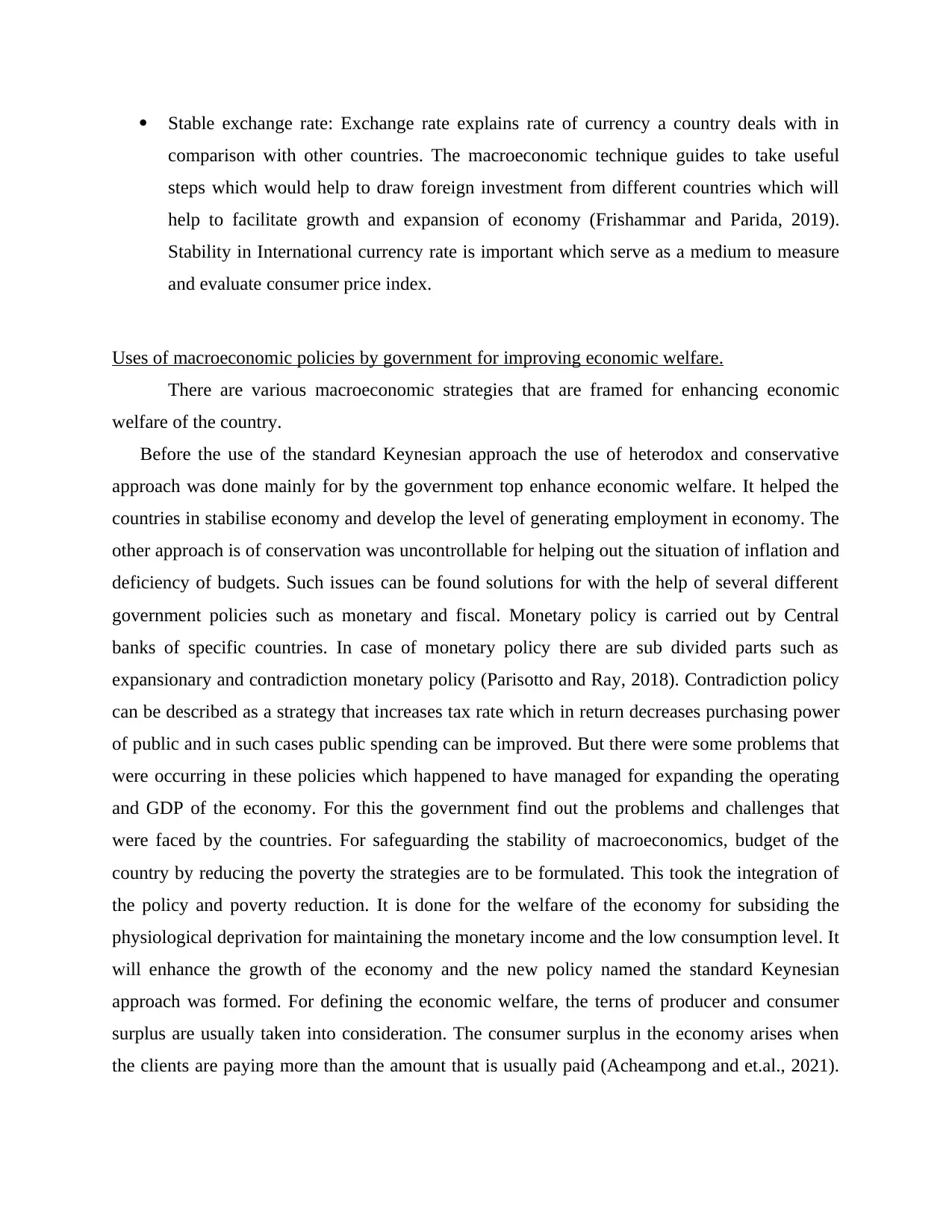
Stable exchange rate: Exchange rate explains rate of currency a country deals with in
comparison with other countries. The macroeconomic technique guides to take useful
steps which would help to draw foreign investment from different countries which will
help to facilitate growth and expansion of economy (Frishammar and Parida, 2019).
Stability in International currency rate is important which serve as a medium to measure
and evaluate consumer price index.
Uses of macroeconomic policies by government for improving economic welfare.
There are various macroeconomic strategies that are framed for enhancing economic
welfare of the country.
Before the use of the standard Keynesian approach the use of heterodox and conservative
approach was done mainly for by the government top enhance economic welfare. It helped the
countries in stabilise economy and develop the level of generating employment in economy. The
other approach is of conservation was uncontrollable for helping out the situation of inflation and
deficiency of budgets. Such issues can be found solutions for with the help of several different
government policies such as monetary and fiscal. Monetary policy is carried out by Central
banks of specific countries. In case of monetary policy there are sub divided parts such as
expansionary and contradiction monetary policy (Parisotto and Ray, 2018). Contradiction policy
can be described as a strategy that increases tax rate which in return decreases purchasing power
of public and in such cases public spending can be improved. But there were some problems that
were occurring in these policies which happened to have managed for expanding the operating
and GDP of the economy. For this the government find out the problems and challenges that
were faced by the countries. For safeguarding the stability of macroeconomics, budget of the
country by reducing the poverty the strategies are to be formulated. This took the integration of
the policy and poverty reduction. It is done for the welfare of the economy for subsiding the
physiological deprivation for maintaining the monetary income and the low consumption level. It
will enhance the growth of the economy and the new policy named the standard Keynesian
approach was formed. For defining the economic welfare, the terns of producer and consumer
surplus are usually taken into consideration. The consumer surplus in the economy arises when
the clients are paying more than the amount that is usually paid (Acheampong and et.al., 2021).
comparison with other countries. The macroeconomic technique guides to take useful
steps which would help to draw foreign investment from different countries which will
help to facilitate growth and expansion of economy (Frishammar and Parida, 2019).
Stability in International currency rate is important which serve as a medium to measure
and evaluate consumer price index.
Uses of macroeconomic policies by government for improving economic welfare.
There are various macroeconomic strategies that are framed for enhancing economic
welfare of the country.
Before the use of the standard Keynesian approach the use of heterodox and conservative
approach was done mainly for by the government top enhance economic welfare. It helped the
countries in stabilise economy and develop the level of generating employment in economy. The
other approach is of conservation was uncontrollable for helping out the situation of inflation and
deficiency of budgets. Such issues can be found solutions for with the help of several different
government policies such as monetary and fiscal. Monetary policy is carried out by Central
banks of specific countries. In case of monetary policy there are sub divided parts such as
expansionary and contradiction monetary policy (Parisotto and Ray, 2018). Contradiction policy
can be described as a strategy that increases tax rate which in return decreases purchasing power
of public and in such cases public spending can be improved. But there were some problems that
were occurring in these policies which happened to have managed for expanding the operating
and GDP of the economy. For this the government find out the problems and challenges that
were faced by the countries. For safeguarding the stability of macroeconomics, budget of the
country by reducing the poverty the strategies are to be formulated. This took the integration of
the policy and poverty reduction. It is done for the welfare of the economy for subsiding the
physiological deprivation for maintaining the monetary income and the low consumption level. It
will enhance the growth of the economy and the new policy named the standard Keynesian
approach was formed. For defining the economic welfare, the terns of producer and consumer
surplus are usually taken into consideration. The consumer surplus in the economy arises when
the clients are paying more than the amount that is usually paid (Acheampong and et.al., 2021).
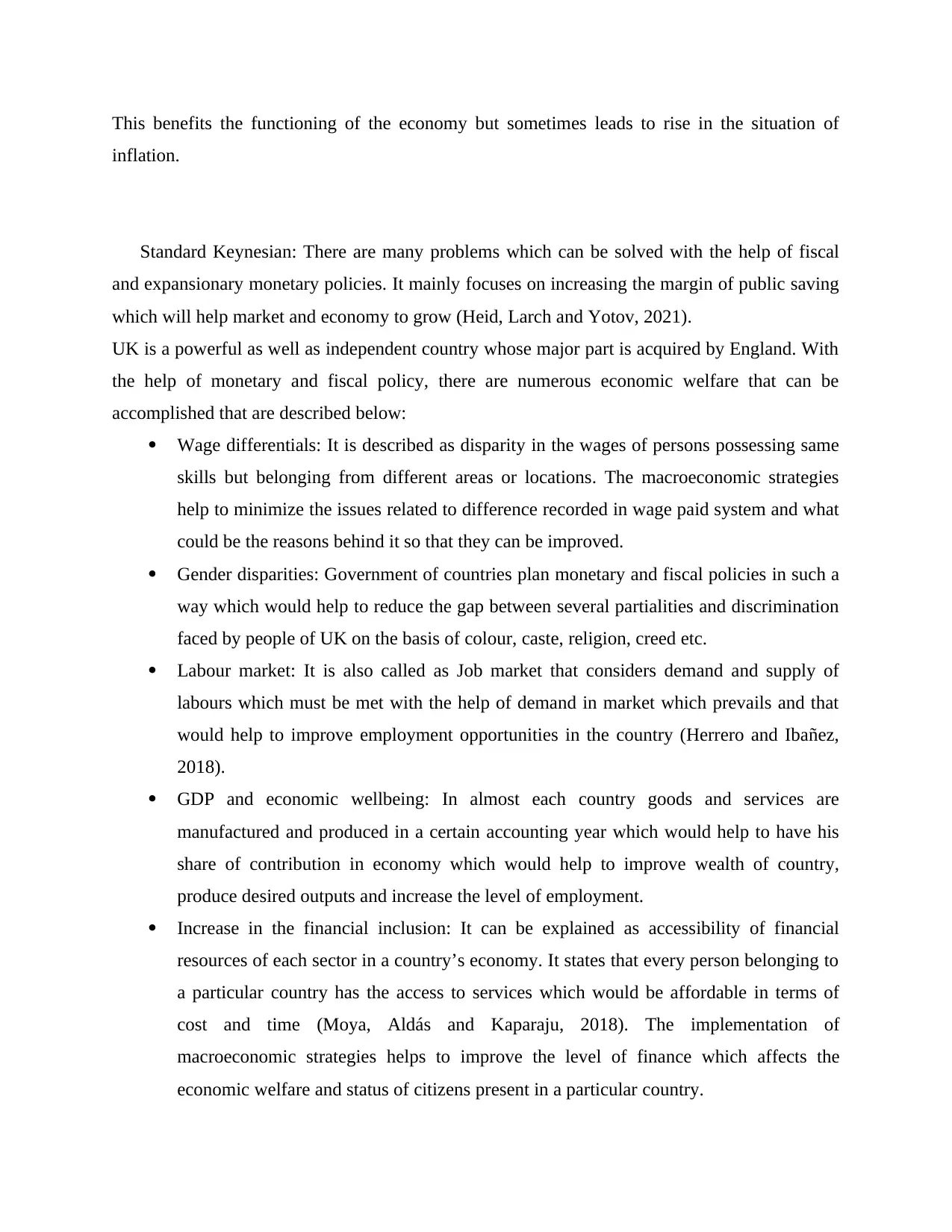
This benefits the functioning of the economy but sometimes leads to rise in the situation of
inflation.
Standard Keynesian: There are many problems which can be solved with the help of fiscal
and expansionary monetary policies. It mainly focuses on increasing the margin of public saving
which will help market and economy to grow (Heid, Larch and Yotov, 2021).
UK is a powerful as well as independent country whose major part is acquired by England. With
the help of monetary and fiscal policy, there are numerous economic welfare that can be
accomplished that are described below:
Wage differentials: It is described as disparity in the wages of persons possessing same
skills but belonging from different areas or locations. The macroeconomic strategies
help to minimize the issues related to difference recorded in wage paid system and what
could be the reasons behind it so that they can be improved.
Gender disparities: Government of countries plan monetary and fiscal policies in such a
way which would help to reduce the gap between several partialities and discrimination
faced by people of UK on the basis of colour, caste, religion, creed etc.
Labour market: It is also called as Job market that considers demand and supply of
labours which must be met with the help of demand in market which prevails and that
would help to improve employment opportunities in the country (Herrero and Ibañez,
2018).
GDP and economic wellbeing: In almost each country goods and services are
manufactured and produced in a certain accounting year which would help to have his
share of contribution in economy which would help to improve wealth of country,
produce desired outputs and increase the level of employment.
Increase in the financial inclusion: It can be explained as accessibility of financial
resources of each sector in a country’s economy. It states that every person belonging to
a particular country has the access to services which would be affordable in terms of
cost and time (Moya, Aldás and Kaparaju, 2018). The implementation of
macroeconomic strategies helps to improve the level of finance which affects the
economic welfare and status of citizens present in a particular country.
inflation.
Standard Keynesian: There are many problems which can be solved with the help of fiscal
and expansionary monetary policies. It mainly focuses on increasing the margin of public saving
which will help market and economy to grow (Heid, Larch and Yotov, 2021).
UK is a powerful as well as independent country whose major part is acquired by England. With
the help of monetary and fiscal policy, there are numerous economic welfare that can be
accomplished that are described below:
Wage differentials: It is described as disparity in the wages of persons possessing same
skills but belonging from different areas or locations. The macroeconomic strategies
help to minimize the issues related to difference recorded in wage paid system and what
could be the reasons behind it so that they can be improved.
Gender disparities: Government of countries plan monetary and fiscal policies in such a
way which would help to reduce the gap between several partialities and discrimination
faced by people of UK on the basis of colour, caste, religion, creed etc.
Labour market: It is also called as Job market that considers demand and supply of
labours which must be met with the help of demand in market which prevails and that
would help to improve employment opportunities in the country (Herrero and Ibañez,
2018).
GDP and economic wellbeing: In almost each country goods and services are
manufactured and produced in a certain accounting year which would help to have his
share of contribution in economy which would help to improve wealth of country,
produce desired outputs and increase the level of employment.
Increase in the financial inclusion: It can be explained as accessibility of financial
resources of each sector in a country’s economy. It states that every person belonging to
a particular country has the access to services which would be affordable in terms of
cost and time (Moya, Aldás and Kaparaju, 2018). The implementation of
macroeconomic strategies helps to improve the level of finance which affects the
economic welfare and status of citizens present in a particular country.
⊘ This is a preview!⊘
Do you want full access?
Subscribe today to unlock all pages.

Trusted by 1+ million students worldwide
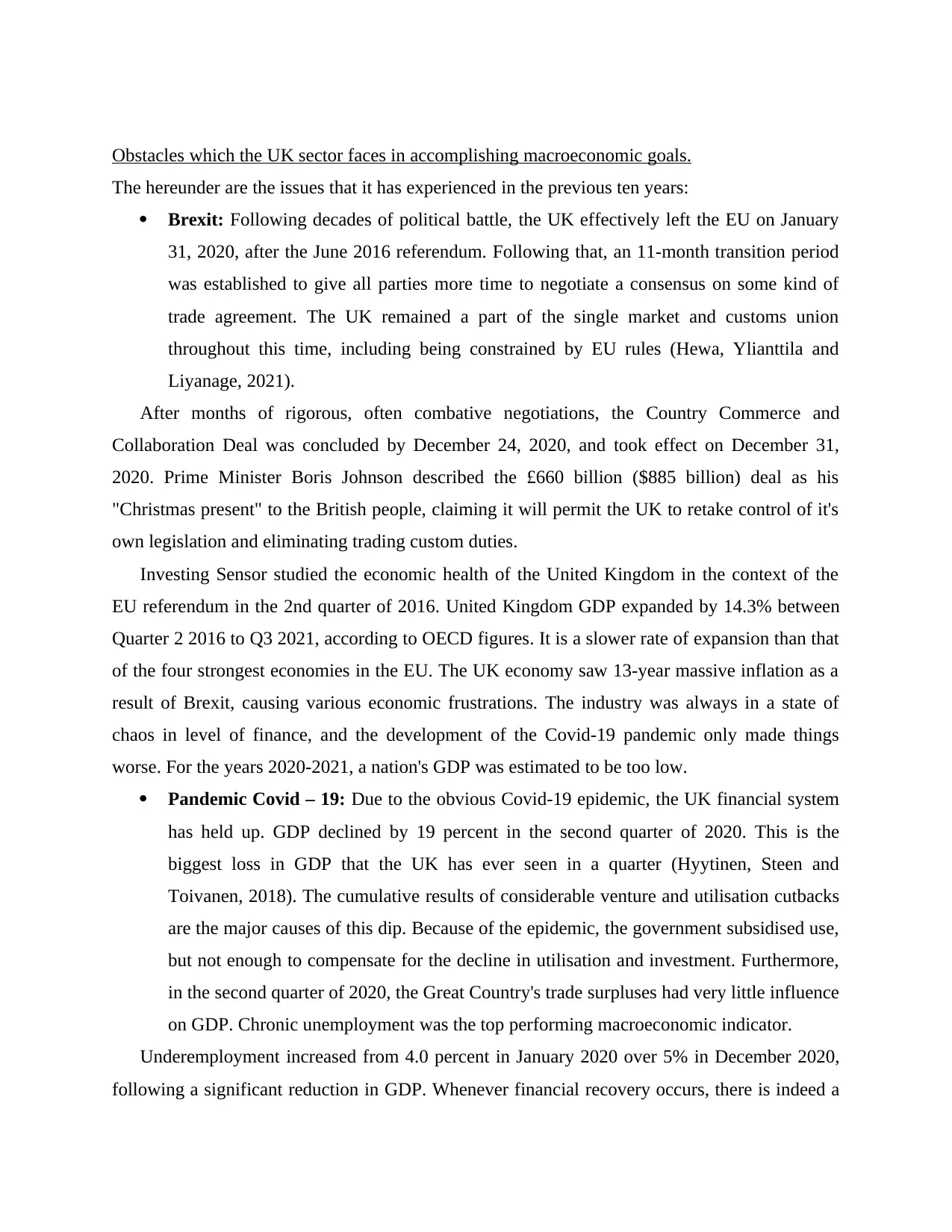
Obstacles which the UK sector faces in accomplishing macroeconomic goals.
The hereunder are the issues that it has experienced in the previous ten years:
Brexit: Following decades of political battle, the UK effectively left the EU on January
31, 2020, after the June 2016 referendum. Following that, an 11-month transition period
was established to give all parties more time to negotiate a consensus on some kind of
trade agreement. The UK remained a part of the single market and customs union
throughout this time, including being constrained by EU rules (Hewa, Ylianttila and
Liyanage, 2021).
After months of rigorous, often combative negotiations, the Country Commerce and
Collaboration Deal was concluded by December 24, 2020, and took effect on December 31,
2020. Prime Minister Boris Johnson described the £660 billion ($885 billion) deal as his
"Christmas present" to the British people, claiming it will permit the UK to retake control of it's
own legislation and eliminating trading custom duties.
Investing Sensor studied the economic health of the United Kingdom in the context of the
EU referendum in the 2nd quarter of 2016. United Kingdom GDP expanded by 14.3% between
Quarter 2 2016 to Q3 2021, according to OECD figures. It is a slower rate of expansion than that
of the four strongest economies in the EU. The UK economy saw 13-year massive inflation as a
result of Brexit, causing various economic frustrations. The industry was always in a state of
chaos in level of finance, and the development of the Covid-19 pandemic only made things
worse. For the years 2020-2021, a nation's GDP was estimated to be too low.
Pandemic Covid – 19: Due to the obvious Covid-19 epidemic, the UK financial system
has held up. GDP declined by 19 percent in the second quarter of 2020. This is the
biggest loss in GDP that the UK has ever seen in a quarter (Hyytinen, Steen and
Toivanen, 2018). The cumulative results of considerable venture and utilisation cutbacks
are the major causes of this dip. Because of the epidemic, the government subsidised use,
but not enough to compensate for the decline in utilisation and investment. Furthermore,
in the second quarter of 2020, the Great Country's trade surpluses had very little influence
on GDP. Chronic unemployment was the top performing macroeconomic indicator.
Underemployment increased from 4.0 percent in January 2020 over 5% in December 2020,
following a significant reduction in GDP. Whenever financial recovery occurs, there is indeed a
The hereunder are the issues that it has experienced in the previous ten years:
Brexit: Following decades of political battle, the UK effectively left the EU on January
31, 2020, after the June 2016 referendum. Following that, an 11-month transition period
was established to give all parties more time to negotiate a consensus on some kind of
trade agreement. The UK remained a part of the single market and customs union
throughout this time, including being constrained by EU rules (Hewa, Ylianttila and
Liyanage, 2021).
After months of rigorous, often combative negotiations, the Country Commerce and
Collaboration Deal was concluded by December 24, 2020, and took effect on December 31,
2020. Prime Minister Boris Johnson described the £660 billion ($885 billion) deal as his
"Christmas present" to the British people, claiming it will permit the UK to retake control of it's
own legislation and eliminating trading custom duties.
Investing Sensor studied the economic health of the United Kingdom in the context of the
EU referendum in the 2nd quarter of 2016. United Kingdom GDP expanded by 14.3% between
Quarter 2 2016 to Q3 2021, according to OECD figures. It is a slower rate of expansion than that
of the four strongest economies in the EU. The UK economy saw 13-year massive inflation as a
result of Brexit, causing various economic frustrations. The industry was always in a state of
chaos in level of finance, and the development of the Covid-19 pandemic only made things
worse. For the years 2020-2021, a nation's GDP was estimated to be too low.
Pandemic Covid – 19: Due to the obvious Covid-19 epidemic, the UK financial system
has held up. GDP declined by 19 percent in the second quarter of 2020. This is the
biggest loss in GDP that the UK has ever seen in a quarter (Hyytinen, Steen and
Toivanen, 2018). The cumulative results of considerable venture and utilisation cutbacks
are the major causes of this dip. Because of the epidemic, the government subsidised use,
but not enough to compensate for the decline in utilisation and investment. Furthermore,
in the second quarter of 2020, the Great Country's trade surpluses had very little influence
on GDP. Chronic unemployment was the top performing macroeconomic indicator.
Underemployment increased from 4.0 percent in January 2020 over 5% in December 2020,
following a significant reduction in GDP. Whenever financial recovery occurs, there is indeed a
Paraphrase This Document
Need a fresh take? Get an instant paraphrase of this document with our AI Paraphraser
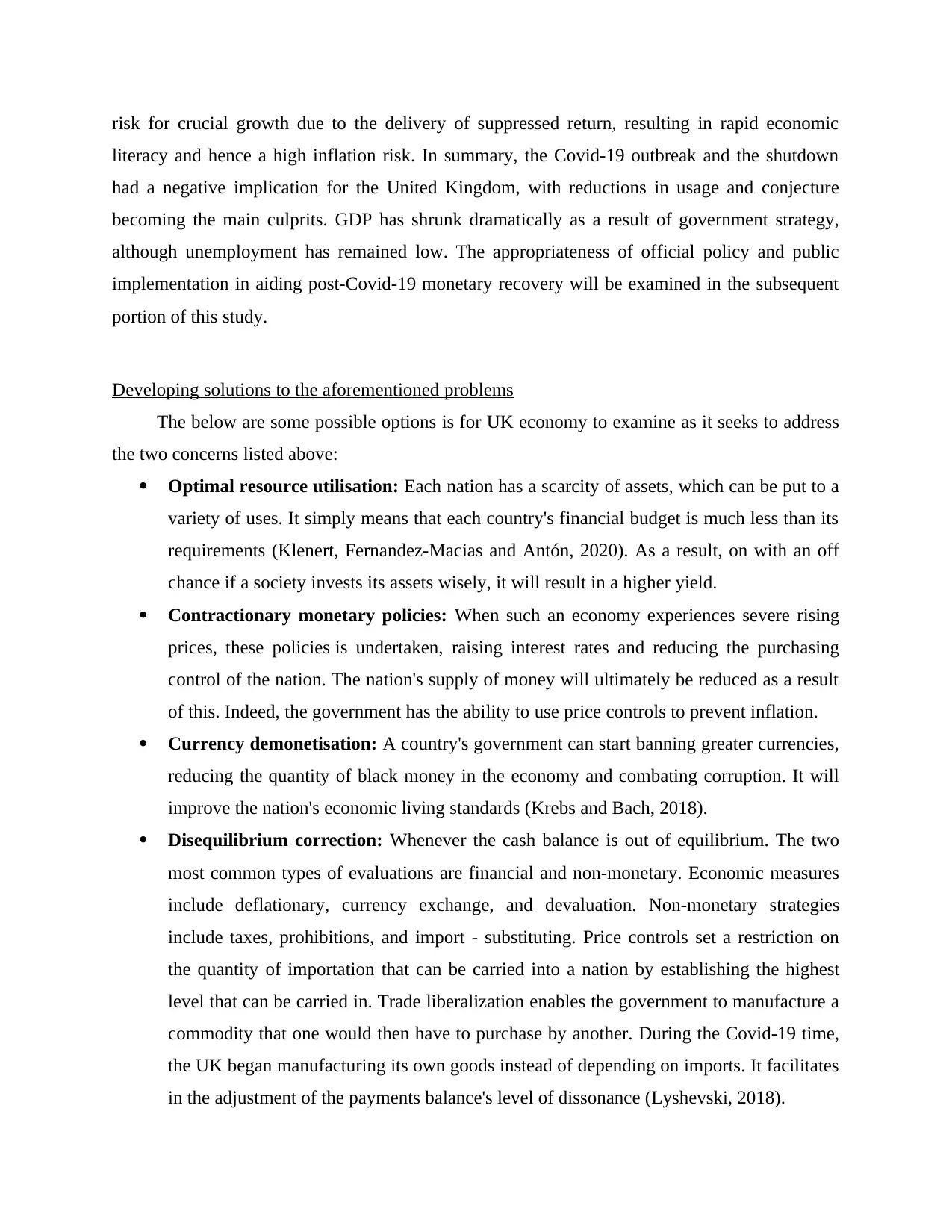
risk for crucial growth due to the delivery of suppressed return, resulting in rapid economic
literacy and hence a high inflation risk. In summary, the Covid-19 outbreak and the shutdown
had a negative implication for the United Kingdom, with reductions in usage and conjecture
becoming the main culprits. GDP has shrunk dramatically as a result of government strategy,
although unemployment has remained low. The appropriateness of official policy and public
implementation in aiding post-Covid-19 monetary recovery will be examined in the subsequent
portion of this study.
Developing solutions to the aforementioned problems
The below are some possible options is for UK economy to examine as it seeks to address
the two concerns listed above:
Optimal resource utilisation: Each nation has a scarcity of assets, which can be put to a
variety of uses. It simply means that each country's financial budget is much less than its
requirements (Klenert, Fernandez-Macias and Antón, 2020). As a result, on with an off
chance if a society invests its assets wisely, it will result in a higher yield.
Contractionary monetary policies: When such an economy experiences severe rising
prices, these policies is undertaken, raising interest rates and reducing the purchasing
control of the nation. The nation's supply of money will ultimately be reduced as a result
of this. Indeed, the government has the ability to use price controls to prevent inflation.
Currency demonetisation: A country's government can start banning greater currencies,
reducing the quantity of black money in the economy and combating corruption. It will
improve the nation's economic living standards (Krebs and Bach, 2018).
Disequilibrium correction: Whenever the cash balance is out of equilibrium. The two
most common types of evaluations are financial and non-monetary. Economic measures
include deflationary, currency exchange, and devaluation. Non-monetary strategies
include taxes, prohibitions, and import - substituting. Price controls set a restriction on
the quantity of importation that can be carried into a nation by establishing the highest
level that can be carried in. Trade liberalization enables the government to manufacture a
commodity that one would then have to purchase by another. During the Covid-19 time,
the UK began manufacturing its own goods instead of depending on imports. It facilitates
in the adjustment of the payments balance's level of dissonance (Lyshevski, 2018).
literacy and hence a high inflation risk. In summary, the Covid-19 outbreak and the shutdown
had a negative implication for the United Kingdom, with reductions in usage and conjecture
becoming the main culprits. GDP has shrunk dramatically as a result of government strategy,
although unemployment has remained low. The appropriateness of official policy and public
implementation in aiding post-Covid-19 monetary recovery will be examined in the subsequent
portion of this study.
Developing solutions to the aforementioned problems
The below are some possible options is for UK economy to examine as it seeks to address
the two concerns listed above:
Optimal resource utilisation: Each nation has a scarcity of assets, which can be put to a
variety of uses. It simply means that each country's financial budget is much less than its
requirements (Klenert, Fernandez-Macias and Antón, 2020). As a result, on with an off
chance if a society invests its assets wisely, it will result in a higher yield.
Contractionary monetary policies: When such an economy experiences severe rising
prices, these policies is undertaken, raising interest rates and reducing the purchasing
control of the nation. The nation's supply of money will ultimately be reduced as a result
of this. Indeed, the government has the ability to use price controls to prevent inflation.
Currency demonetisation: A country's government can start banning greater currencies,
reducing the quantity of black money in the economy and combating corruption. It will
improve the nation's economic living standards (Krebs and Bach, 2018).
Disequilibrium correction: Whenever the cash balance is out of equilibrium. The two
most common types of evaluations are financial and non-monetary. Economic measures
include deflationary, currency exchange, and devaluation. Non-monetary strategies
include taxes, prohibitions, and import - substituting. Price controls set a restriction on
the quantity of importation that can be carried into a nation by establishing the highest
level that can be carried in. Trade liberalization enables the government to manufacture a
commodity that one would then have to purchase by another. During the Covid-19 time,
the UK began manufacturing its own goods instead of depending on imports. It facilitates
in the adjustment of the payments balance's level of dissonance (Lyshevski, 2018).
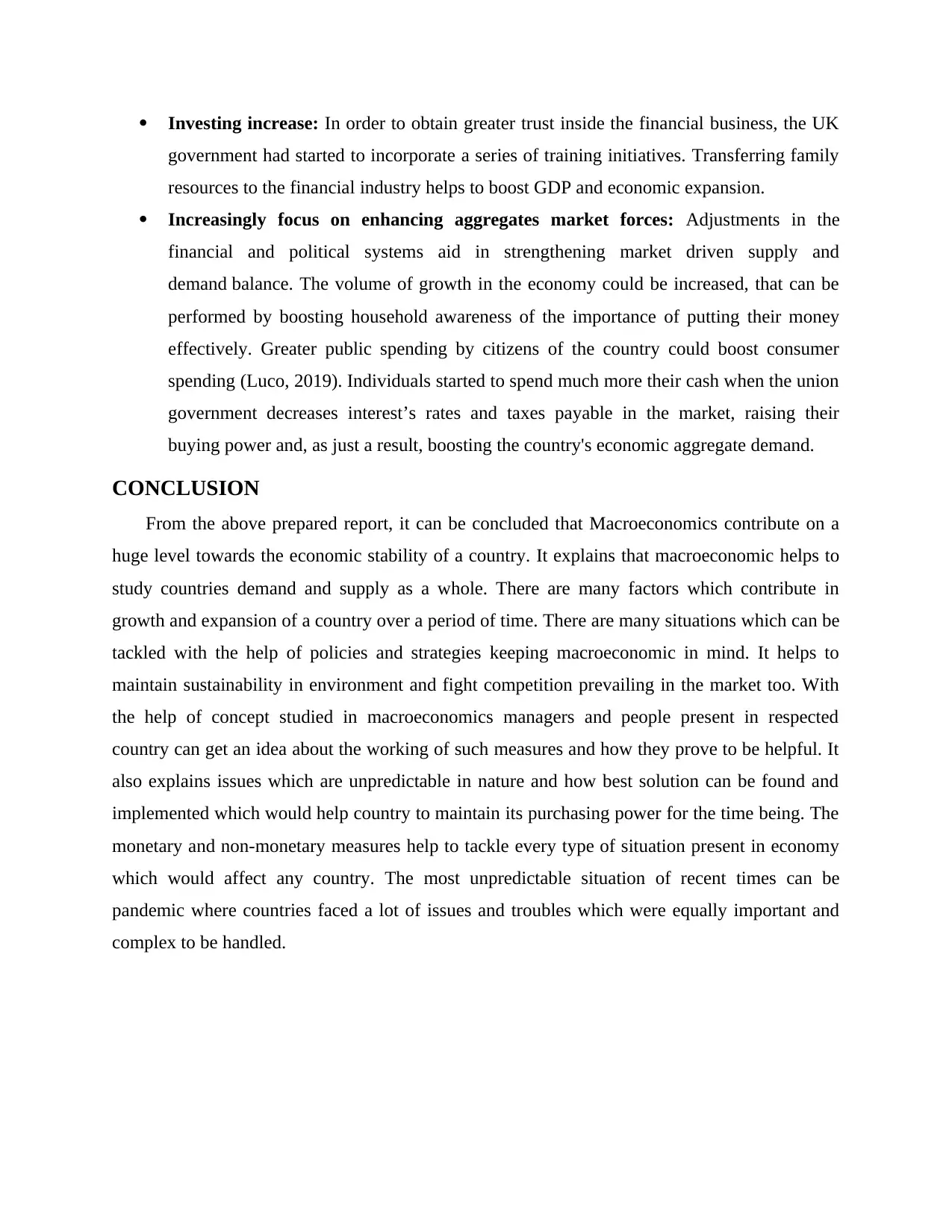
Investing increase: In order to obtain greater trust inside the financial business, the UK
government had started to incorporate a series of training initiatives. Transferring family
resources to the financial industry helps to boost GDP and economic expansion.
Increasingly focus on enhancing aggregates market forces: Adjustments in the
financial and political systems aid in strengthening market driven supply and
demand balance. The volume of growth in the economy could be increased, that can be
performed by boosting household awareness of the importance of putting their money
effectively. Greater public spending by citizens of the country could boost consumer
spending (Luco, 2019). Individuals started to spend much more their cash when the union
government decreases interest’s rates and taxes payable in the market, raising their
buying power and, as just a result, boosting the country's economic aggregate demand.
CONCLUSION
From the above prepared report, it can be concluded that Macroeconomics contribute on a
huge level towards the economic stability of a country. It explains that macroeconomic helps to
study countries demand and supply as a whole. There are many factors which contribute in
growth and expansion of a country over a period of time. There are many situations which can be
tackled with the help of policies and strategies keeping macroeconomic in mind. It helps to
maintain sustainability in environment and fight competition prevailing in the market too. With
the help of concept studied in macroeconomics managers and people present in respected
country can get an idea about the working of such measures and how they prove to be helpful. It
also explains issues which are unpredictable in nature and how best solution can be found and
implemented which would help country to maintain its purchasing power for the time being. The
monetary and non-monetary measures help to tackle every type of situation present in economy
which would affect any country. The most unpredictable situation of recent times can be
pandemic where countries faced a lot of issues and troubles which were equally important and
complex to be handled.
government had started to incorporate a series of training initiatives. Transferring family
resources to the financial industry helps to boost GDP and economic expansion.
Increasingly focus on enhancing aggregates market forces: Adjustments in the
financial and political systems aid in strengthening market driven supply and
demand balance. The volume of growth in the economy could be increased, that can be
performed by boosting household awareness of the importance of putting their money
effectively. Greater public spending by citizens of the country could boost consumer
spending (Luco, 2019). Individuals started to spend much more their cash when the union
government decreases interest’s rates and taxes payable in the market, raising their
buying power and, as just a result, boosting the country's economic aggregate demand.
CONCLUSION
From the above prepared report, it can be concluded that Macroeconomics contribute on a
huge level towards the economic stability of a country. It explains that macroeconomic helps to
study countries demand and supply as a whole. There are many factors which contribute in
growth and expansion of a country over a period of time. There are many situations which can be
tackled with the help of policies and strategies keeping macroeconomic in mind. It helps to
maintain sustainability in environment and fight competition prevailing in the market too. With
the help of concept studied in macroeconomics managers and people present in respected
country can get an idea about the working of such measures and how they prove to be helpful. It
also explains issues which are unpredictable in nature and how best solution can be found and
implemented which would help country to maintain its purchasing power for the time being. The
monetary and non-monetary measures help to tackle every type of situation present in economy
which would affect any country. The most unpredictable situation of recent times can be
pandemic where countries faced a lot of issues and troubles which were equally important and
complex to be handled.
⊘ This is a preview!⊘
Do you want full access?
Subscribe today to unlock all pages.

Trusted by 1+ million students worldwide

Paraphrase This Document
Need a fresh take? Get an instant paraphrase of this document with our AI Paraphraser
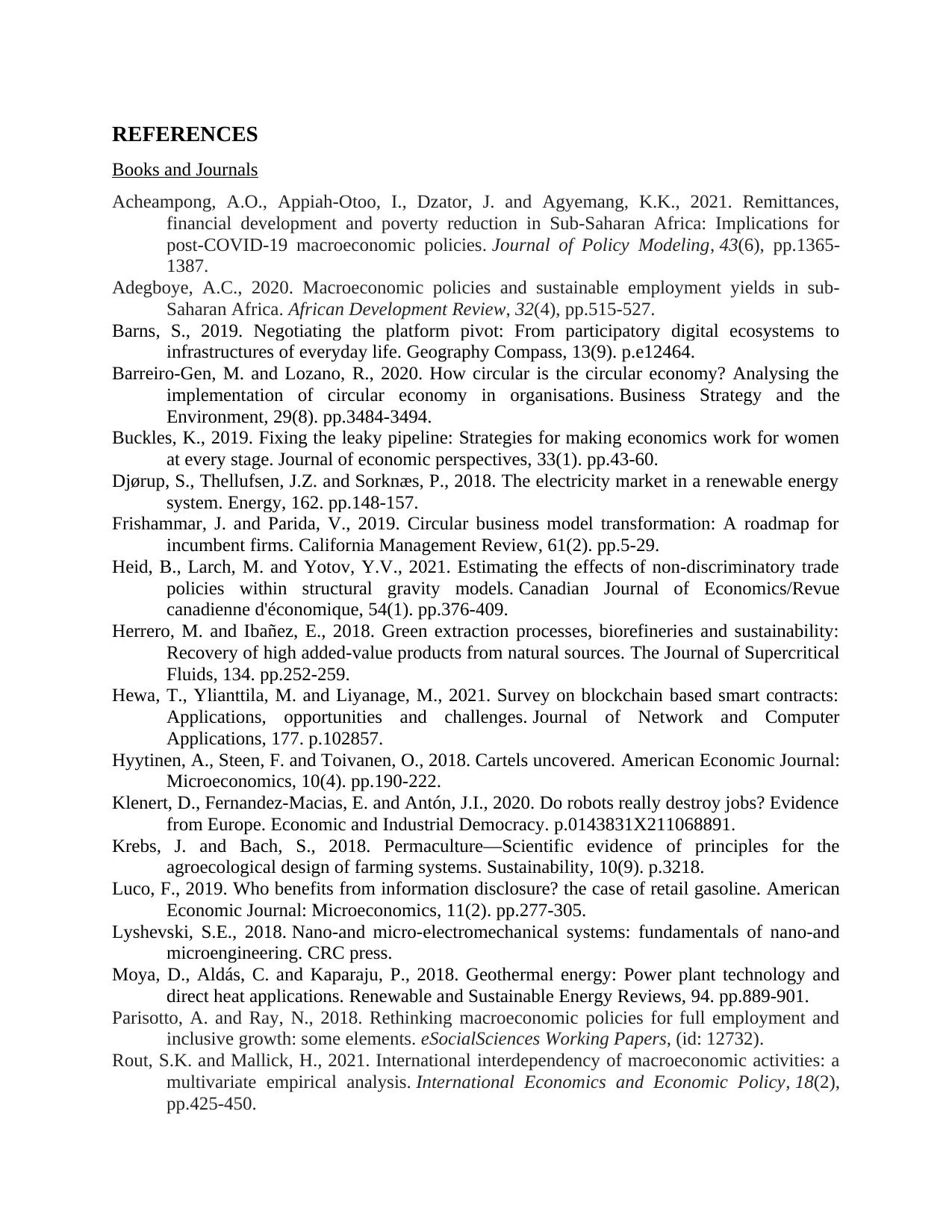
REFERENCES
Books and Journals
Acheampong, A.O., Appiah-Otoo, I., Dzator, J. and Agyemang, K.K., 2021. Remittances,
financial development and poverty reduction in Sub-Saharan Africa: Implications for
post-COVID-19 macroeconomic policies. Journal of Policy Modeling, 43(6), pp.1365-
1387.
Adegboye, A.C., 2020. Macroeconomic policies and sustainable employment yields in sub‐
Saharan Africa. African Development Review, 32(4), pp.515-527.
Barns, S., 2019. Negotiating the platform pivot: From participatory digital ecosystems to
infrastructures of everyday life. Geography Compass, 13(9). p.e12464.
Barreiro‐Gen, M. and Lozano, R., 2020. How circular is the circular economy? Analysing the
implementation of circular economy in organisations. Business Strategy and the
Environment, 29(8). pp.3484-3494.
Buckles, K., 2019. Fixing the leaky pipeline: Strategies for making economics work for women
at every stage. Journal of economic perspectives, 33(1). pp.43-60.
Djørup, S., Thellufsen, J.Z. and Sorknæs, P., 2018. The electricity market in a renewable energy
system. Energy, 162. pp.148-157.
Frishammar, J. and Parida, V., 2019. Circular business model transformation: A roadmap for
incumbent firms. California Management Review, 61(2). pp.5-29.
Heid, B., Larch, M. and Yotov, Y.V., 2021. Estimating the effects of non‐discriminatory trade
policies within structural gravity models. Canadian Journal of Economics/Revue
canadienne d'économique, 54(1). pp.376-409.
Herrero, M. and Ibañez, E., 2018. Green extraction processes, biorefineries and sustainability:
Recovery of high added-value products from natural sources. The Journal of Supercritical
Fluids, 134. pp.252-259.
Hewa, T., Ylianttila, M. and Liyanage, M., 2021. Survey on blockchain based smart contracts:
Applications, opportunities and challenges. Journal of Network and Computer
Applications, 177. p.102857.
Hyytinen, A., Steen, F. and Toivanen, O., 2018. Cartels uncovered. American Economic Journal:
Microeconomics, 10(4). pp.190-222.
Klenert, D., Fernandez-Macias, E. and Antón, J.I., 2020. Do robots really destroy jobs? Evidence
from Europe. Economic and Industrial Democracy. p.0143831X211068891.
Krebs, J. and Bach, S., 2018. Permaculture—Scientific evidence of principles for the
agroecological design of farming systems. Sustainability, 10(9). p.3218.
Luco, F., 2019. Who benefits from information disclosure? the case of retail gasoline. American
Economic Journal: Microeconomics, 11(2). pp.277-305.
Lyshevski, S.E., 2018. Nano-and micro-electromechanical systems: fundamentals of nano-and
microengineering. CRC press.
Moya, D., Aldás, C. and Kaparaju, P., 2018. Geothermal energy: Power plant technology and
direct heat applications. Renewable and Sustainable Energy Reviews, 94. pp.889-901.
Parisotto, A. and Ray, N., 2018. Rethinking macroeconomic policies for full employment and
inclusive growth: some elements. eSocialSciences Working Papers, (id: 12732).
Rout, S.K. and Mallick, H., 2021. International interdependency of macroeconomic activities: a
multivariate empirical analysis. International Economics and Economic Policy, 18(2),
pp.425-450.
Books and Journals
Acheampong, A.O., Appiah-Otoo, I., Dzator, J. and Agyemang, K.K., 2021. Remittances,
financial development and poverty reduction in Sub-Saharan Africa: Implications for
post-COVID-19 macroeconomic policies. Journal of Policy Modeling, 43(6), pp.1365-
1387.
Adegboye, A.C., 2020. Macroeconomic policies and sustainable employment yields in sub‐
Saharan Africa. African Development Review, 32(4), pp.515-527.
Barns, S., 2019. Negotiating the platform pivot: From participatory digital ecosystems to
infrastructures of everyday life. Geography Compass, 13(9). p.e12464.
Barreiro‐Gen, M. and Lozano, R., 2020. How circular is the circular economy? Analysing the
implementation of circular economy in organisations. Business Strategy and the
Environment, 29(8). pp.3484-3494.
Buckles, K., 2019. Fixing the leaky pipeline: Strategies for making economics work for women
at every stage. Journal of economic perspectives, 33(1). pp.43-60.
Djørup, S., Thellufsen, J.Z. and Sorknæs, P., 2018. The electricity market in a renewable energy
system. Energy, 162. pp.148-157.
Frishammar, J. and Parida, V., 2019. Circular business model transformation: A roadmap for
incumbent firms. California Management Review, 61(2). pp.5-29.
Heid, B., Larch, M. and Yotov, Y.V., 2021. Estimating the effects of non‐discriminatory trade
policies within structural gravity models. Canadian Journal of Economics/Revue
canadienne d'économique, 54(1). pp.376-409.
Herrero, M. and Ibañez, E., 2018. Green extraction processes, biorefineries and sustainability:
Recovery of high added-value products from natural sources. The Journal of Supercritical
Fluids, 134. pp.252-259.
Hewa, T., Ylianttila, M. and Liyanage, M., 2021. Survey on blockchain based smart contracts:
Applications, opportunities and challenges. Journal of Network and Computer
Applications, 177. p.102857.
Hyytinen, A., Steen, F. and Toivanen, O., 2018. Cartels uncovered. American Economic Journal:
Microeconomics, 10(4). pp.190-222.
Klenert, D., Fernandez-Macias, E. and Antón, J.I., 2020. Do robots really destroy jobs? Evidence
from Europe. Economic and Industrial Democracy. p.0143831X211068891.
Krebs, J. and Bach, S., 2018. Permaculture—Scientific evidence of principles for the
agroecological design of farming systems. Sustainability, 10(9). p.3218.
Luco, F., 2019. Who benefits from information disclosure? the case of retail gasoline. American
Economic Journal: Microeconomics, 11(2). pp.277-305.
Lyshevski, S.E., 2018. Nano-and micro-electromechanical systems: fundamentals of nano-and
microengineering. CRC press.
Moya, D., Aldás, C. and Kaparaju, P., 2018. Geothermal energy: Power plant technology and
direct heat applications. Renewable and Sustainable Energy Reviews, 94. pp.889-901.
Parisotto, A. and Ray, N., 2018. Rethinking macroeconomic policies for full employment and
inclusive growth: some elements. eSocialSciences Working Papers, (id: 12732).
Rout, S.K. and Mallick, H., 2021. International interdependency of macroeconomic activities: a
multivariate empirical analysis. International Economics and Economic Policy, 18(2),
pp.425-450.
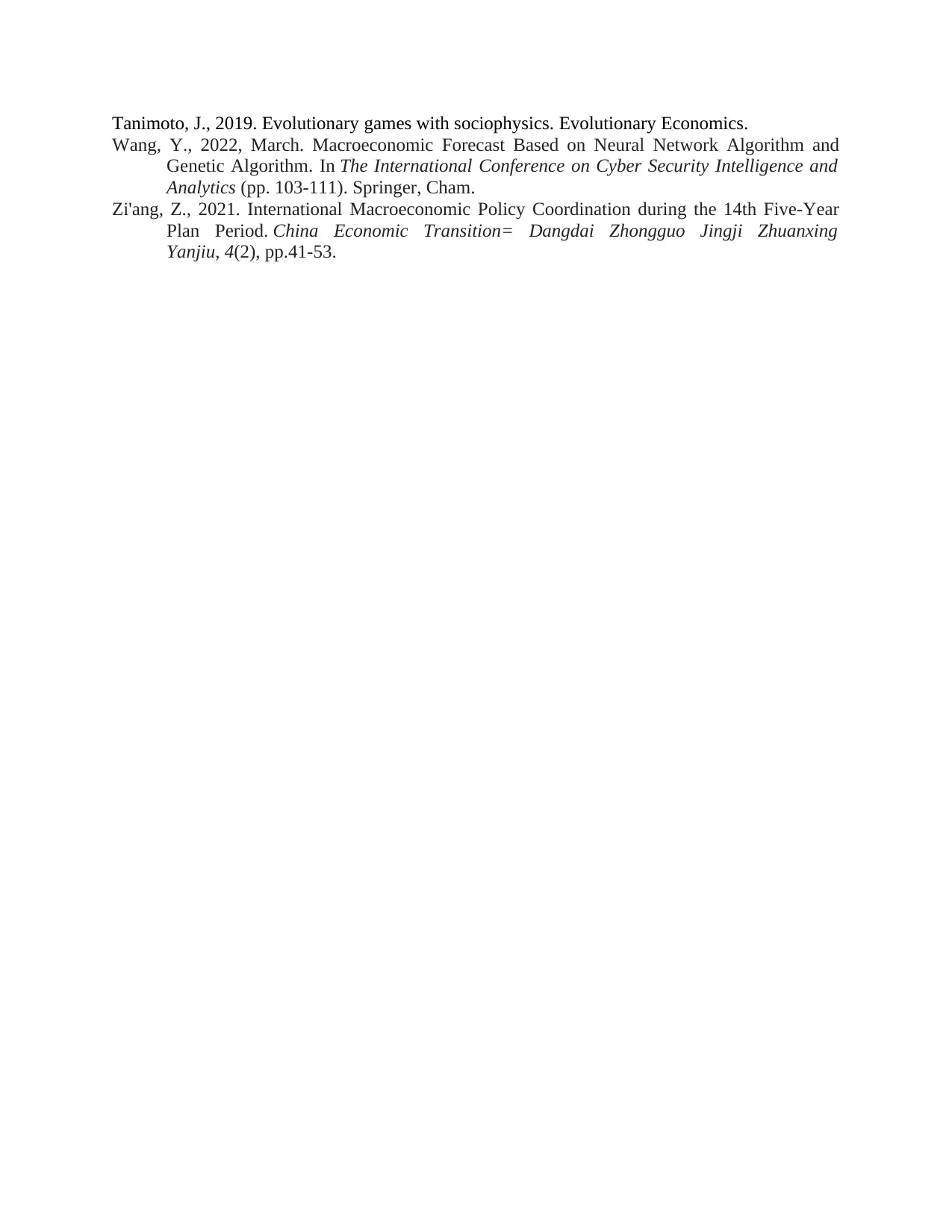
Tanimoto, J., 2019. Evolutionary games with sociophysics. Evolutionary Economics.
Wang, Y., 2022, March. Macroeconomic Forecast Based on Neural Network Algorithm and
Genetic Algorithm. In The International Conference on Cyber Security Intelligence and
Analytics (pp. 103-111). Springer, Cham.
Zi'ang, Z., 2021. International Macroeconomic Policy Coordination during the 14th Five-Year
Plan Period. China Economic Transition= Dangdai Zhongguo Jingji Zhuanxing
Yanjiu, 4(2), pp.41-53.
Wang, Y., 2022, March. Macroeconomic Forecast Based on Neural Network Algorithm and
Genetic Algorithm. In The International Conference on Cyber Security Intelligence and
Analytics (pp. 103-111). Springer, Cham.
Zi'ang, Z., 2021. International Macroeconomic Policy Coordination during the 14th Five-Year
Plan Period. China Economic Transition= Dangdai Zhongguo Jingji Zhuanxing
Yanjiu, 4(2), pp.41-53.
⊘ This is a preview!⊘
Do you want full access?
Subscribe today to unlock all pages.

Trusted by 1+ million students worldwide
1 out of 14
Related Documents
Your All-in-One AI-Powered Toolkit for Academic Success.
+13062052269
info@desklib.com
Available 24*7 on WhatsApp / Email
![[object Object]](/_next/static/media/star-bottom.7253800d.svg)
Unlock your academic potential
Copyright © 2020–2025 A2Z Services. All Rights Reserved. Developed and managed by ZUCOL.





